pH Control Market
pH Control Market Size and Share Forecast Outlook 2025 to 2035
pH control market is projected to grow from USD 4.6 billion in 2025 to USD 6.6 billion by 2035, at a CAGR of 3.7%. Citric Acid will dominate with a 41.0% market share, while beverages will lead the application segment with a 37.0% share.
pH Control Market Forecast and Outlook 2025 to 2035
The pH control market stands at the threshold of a decade-long expansion trajectory that promises to reshape food processing technology and beverage formulation solutions. The market's journey from USD 4.6 billion in 2025 to USD 6.6 billion by 2035 represents substantial growth, the market will rise at a CAGR of 3.7% which demonstrating the accelerating adoption of advanced pH adjustment technology and precision acidification across food manufacturing facilities, beverage operations, and specialty chemical sectors worldwide.
The first half of the decade (2025-2030) will witness the market climbing from USD 4.6 billion to approximately USD 5.4 billion, adding USD 0.8 billion in value, which constitutes 40% of the total forecast growth period. This phase will be characterized by the rapid adoption of citric acid-based pH control systems, driven by increasing food production volumes and the growing need for advanced acidification solutions worldwide. Enhanced formulation capabilities and automated pH monitoring systems will become standard expectations rather than premium options.
The latter half (2030-2035) will witness continued growth from USD 5.4 billion to USD 6.6 billion, representing an addition of USD 1.2 billion or 60% of the decade's expansion. This period will be defined by mass market penetration of sophisticated pH control technologies, integration with comprehensive quality management platforms, and seamless compatibility with existing food processing infrastructure. The market trajectory signals fundamental shifts in how food facilities approach product formulation and quality management, with participants positioned to benefit from growing demand across multiple acidulant types and application segments.
Quick Stats for pH Control Market
- pH Control Market Value (2025): USD 4.6 billion
- pH Control Market Forecast Value (2035): USD 6.6 billion
- pH Control Market Forecast CAGR: 3.7%
- Leading Product in pH Control Market: Citric Acid
- Key Growth Regions in pH Control Market: North America, Europe, and East Asia
- Top Key Players in pH Control Market: Tate & Lyle, ADM, Cargill, Corbion, Jungbunzlauer
- Where revenue comes from - now vs next (industry-level view)
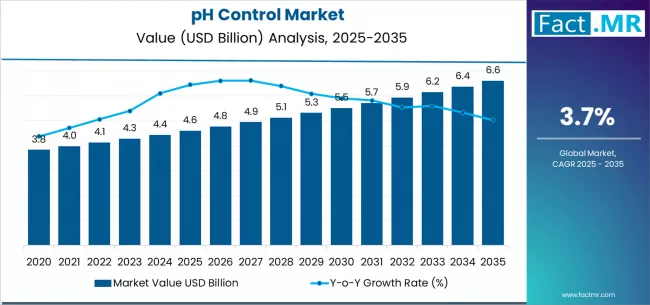
| Period | Primary Revenue Buckets | Share | Notes |
|---|---|---|---|
| Today | Citric acid products | 41% | Natural acidulant, versatile applications |
| Phosphate-based systems | 33% | Buffering capacity, stability enhancement | |
| Other pH control agents | 26% | Specialty chemicals, custom formulations | |
| Technical services | 12% | Application support, formulation assistance | |
| Future (3-5 yrs) | Natural acidulant systems | 38-42% | Clean label trends, organic solutions |
| Multi-functional pH systems | 25-30% | Combined acidification and preservation | |
| Automated dosing solutions | 15-20% | Precise control, real-time adjustment | |
| Specialty buffering systems | 12-18% | Application-specific formulations | |
| Application services | 8-12% | Formulation optimization, technical support | |
| Digital monitoring systems | 5-8% | Process control, quality assurance |
pH Control Market Key Takeaways
At-a-Glance Metrics
| Metric | Value |
|---|---|
| Market Value (2025) → | USD 4.6 billion |
| Market Forecast (2035) ↑ | USD 6.6 billion |
| Growth Rate ★ | 3.7% CAGR |
| Leading Product → | Citric Acid |
| Primary Application → | Beverages Segment |
The market demonstrates strong fundamentals with citric acid capturing a dominant share through natural origin and versatile pH adjustment capabilities for food and beverage applications. Beverage applications drive primary demand, supported by increasing consumption of processed beverages and manufacturing capacity requirements. Geographic expansion remains concentrated in developed markets with established food processing infrastructure, while emerging economies show accelerating adoption rates driven by urbanization and rising quality standards.
Imperatives for Stakeholders in pH Control Market
Design for clean label compliance, not just functionality
- Offer natural solution packages: organic acidulants + application protocols + documentation + technical support + regulatory guidance
- Preconfigured formulations: beverage systems, bakery applications, dairy solutions, and process optimization for food applications
Process integration readiness
- Real-time pH monitoring, automated dosing systems, and manufacturing system integration (process control, batch management)
Quality-by-design approach
- Automated pH control systems, real-time adjustment mechanisms, statistical process control integration, and digital batch documentation
Value-based pricing models
- Clear ingredient price + transparent service tiers (application support, formulation assistance, performance guarantees); subscriptions for technical services and optimization
Segmental Analysis
Primary Classification: The market segments by product into citric acid, phosphates, and other pH control agents, representing the evolution from basic acidification to sophisticated pH management solutions for comprehensive food processing optimization.
Secondary Classification: Application segmentation divides the market into beverages, bakery & confectionery, and dairy/other applications, reflecting distinct requirements for pH control, taste profile, and product stability standards.
Tertiary Classification: Function segmentation covers acidulants, buffers, and stabilizers/others, while regional distribution spans North America, Europe, East Asia, and other global markets with established food processing infrastructure.
The segmentation structure reveals technology progression from standard acidification toward sophisticated pH management systems with enhanced functionality and application-specific capabilities, while application diversity spans from beverage facilities to bakery operations requiring precise pH control solutions.
By Product, the Citric Acid Segment Accounts for Dominant Market Share
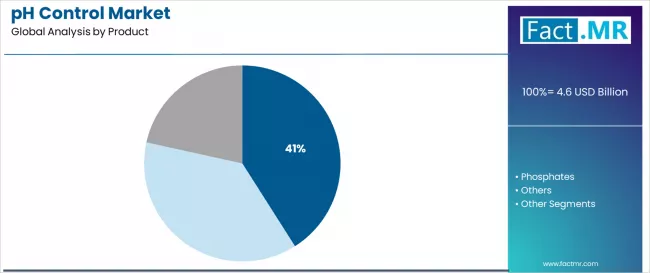
Market Position: Citric Acid systems command the leading position in the pH control market with 41% market share through natural acidification features, including superior taste profile, clean label compatibility, and food processing optimization that enable manufacturing facilities to achieve optimal pH adjustment across diverse food and beverage environments.
Value Drivers: The segment benefits from food facility preference for natural pH control systems that provide effective acidification, consumer acceptance, and regulatory compliance without requiring significant formulation modifications. Natural characteristics enable clean label applications, taste enhancement, and integration with existing food processing equipment, where product quality and consumer acceptance represent critical facility requirements.
Competitive Advantages: Citric Acid systems differentiate through proven natural origin, versatile application characteristics, and integration with automated food processing systems that enhance facility effectiveness while maintaining optimal quality standards suitable for diverse food and beverage applications.
Key market characteristics:
- Natural acidulant designs with optimized pH adjustment and taste profile capabilities
- Enhanced food compatibility, enabling effective acidification with superior taste characteristics
- Processing compatibility, including automated dosing systems, process integration, and quality optimization for food operations
Phosphate-based Systems Show Strong Market Performance
Phosphate-based pH control systems maintain a 33% market position in the pH control market due to their superior buffering capacity and stability enhancement properties. These systems appeal to facilities requiring consistent pH control with enhanced product stability for processed food applications. Market adoption is driven by food processing expansion, emphasizing reliable pH management solutions and operational consistency through proven buffering technologies.
Other pH Control Agents Demonstrate Specialized Applications
Other pH control agents capture 26% market share through specialized pH adjustment in custom formulations, specialty applications, and niche food processing. These facilities demand flexible pH systems capable of handling specific requirements while providing effective acidification and regulatory compliance capabilities.
By Application, the Beverages Segment Shows Market Leadership
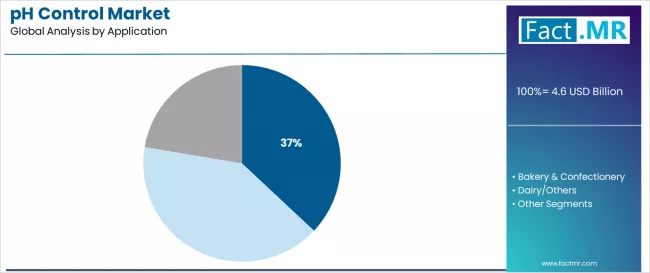
Market Context: Beverages applications demonstrate the highest market position in the pH control market with 37% share due to widespread adoption of pH optimization and increasing focus on beverage quality enhancement, taste profile management, and product stability applications that maximize consumer acceptance while maintaining regulatory standards.
Appeal Factors: Beverage operators prioritize pH control reliability, taste neutrality, and integration with existing processing infrastructure that enables coordinated quality management across multiple product lines. The segment benefits from substantial beverage industry investment and modernization programs that emphasize the implementation of advanced pH control for product optimization and quality assurance applications.
Growth Drivers: Beverage industry expansion programs incorporate pH control as standard processing for product optimization, while functional beverage growth increases demand for precise pH adjustment capabilities that comply with quality standards and enhance product characteristics.
Market Challenges: Varying beverage formulations and pH requirements may limit system standardization across different products or processing scenarios.
Application dynamics include:
- Strong growth in beverage manufacturing and functional drink production requiring comprehensive pH management
- Increasing adoption in quality enhancement and product stability applications for beverage operators
- Rising integration with automated processing systems for pH optimization and consistency assurance
Bakery & Confectionery Applications Maintain Strong Demand
Bakery & confectionery applications capture 32% market share through specialized pH control in baked goods production, confectionery manufacturing, and texture optimization. These facilities demand effective pH systems capable of enhancing product quality while providing reliable processing performance and regulatory compliance capabilities.
Dairy/Other Applications Show Diversified Growth
Dairy and other applications account for 31% market share, including dairy processing, meat products, and specialty food manufacturing requiring pH control capabilities for quality enhancement and product stability.
By Function, Acidulants Drive Market Leadership
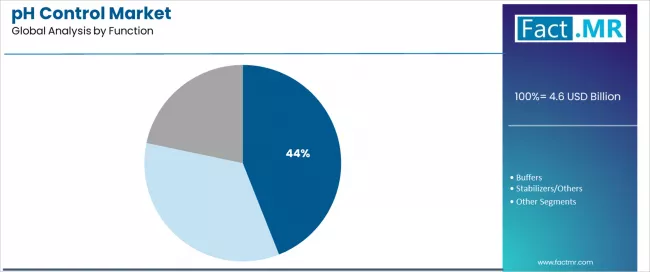
Market Context: Acidulants dominate the market with 44% share, reflecting the primary demand source for pH reduction technology in food processing and beverage manufacturing operations.
Business Model Advantages: Acidulant applications provide direct market demand for pH control chemicals, driving product innovation and formulation enhancement while maintaining taste quality and regulatory compliance requirements.
Operational Benefits: Acidulant functions include taste enhancement, preservation support, and product optimization that drive consistent demand for pH control solutions while providing access to latest food processing technologies.
What are the Drivers, Restraints, and Key Trends of the pH Control Market?
| Category | Factor | Impact | Why It Matters |
|---|---|---|---|
| Driver | Clean label trends & natural ingredient demand | ★★★★★ | Consumer preference for natural acidulants drives demand for citric acid and organic pH control solutions with transparent sourcing |
| Driver | Beverage industry expansion & functional drink growth | ★★★★★ | Increasing beverage consumption and functional product development require precise pH control for taste and stability optimization |
| Driver | Food processing automation & quality standardization | ★★★★☆ | Automated food processing requires consistent pH control systems; precision dosing and monitoring becoming standard requirements |
| Restraint | Raw material price volatility & supply chain challenges | ★★★★☆ | Citric acid and phosphate price fluctuations impact margins; supply chain disruptions affect availability and cost predictability |
| Restraint | Regulatory complexity & approval processes | ★★★☆☆ | Food additive regulations vary by region, requiring extensive documentation and approval processes for new pH control solutions |
| Trend | Multi-functional ingredient systems & process optimization | ★★★★★ | Demand for ingredients providing pH control plus preservation or flavor enhancement; integrated solutions gaining market acceptance |
| Trend | Sustainability & eco-friendly processing solutions | ★★★★☆ | Environmental concerns drive development of sustainable pH control systems; bio-based and biodegradable solutions expanding market |
Analysis of the pH Control Market by Key Country
The pH control market demonstrates varied regional dynamics with Growth Leaders including USA (4.1% growth rate) and Mexico (3.8% growth rate) driving expansion through food processing modernization and beverage industry development. Steady Performers encompass Germany (3.4% growth rate), France (3.3% growth rate), and UK (3.2% growth rate), benefiting from established food industries and advanced processing technology adoption. Emerging Markets feature South Korea (3.2% growth rate) and Japan (3.0% growth rate), where food processing initiatives and manufacturing modernization support consistent growth patterns.
Regional synthesis reveals North American markets leading adoption through food industry expansion and processing optimization, while European countries maintain steady expansion supported by food technology advancement and quality standardization requirements. Asian markets show moderate growth driven by food processing applications and manufacturing development trends.
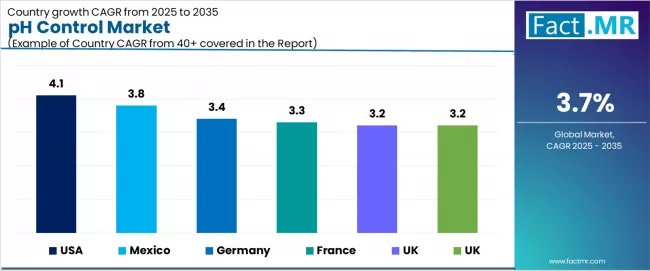
| Region/Country | 2025-2035 Growth | How to win | What to watch out |
|---|---|---|---|
| USA | 4.1% | Focus on clean label solutions | Raw material costs; regulatory changes |
| Mexico | 3.8% | Offer cost-effective systems | Import duties; technical support availability |
| Germany | 3.4% | Provide premium quality control | Over-engineering; lengthy approval cycles |
| France | 3.3% | Lead with natural ingredients | Market competition; supply chain issues |
| UK | 3.2% | Push process integration | Brexit impacts; regulatory complexity |
| South Korea | 3.2% | Target processed food sector | Technology localization requirements |
USA Drives Market Leadership
USA establishes market leadership through comprehensive food processing programs and advanced manufacturing infrastructure development, integrating pH control systems across food and beverage applications. The country's 4.1% growth rate reflects established food industry relationships and mature pH control technology adoption that supports widespread use of acidulation systems in food processing and beverage manufacturing facilities. Growth concentrates in major food processing centers, including California, Illinois, and Texas, where food technology showcases mature pH control deployment that appeals to food operators seeking proven acidification capabilities and quality optimization applications.
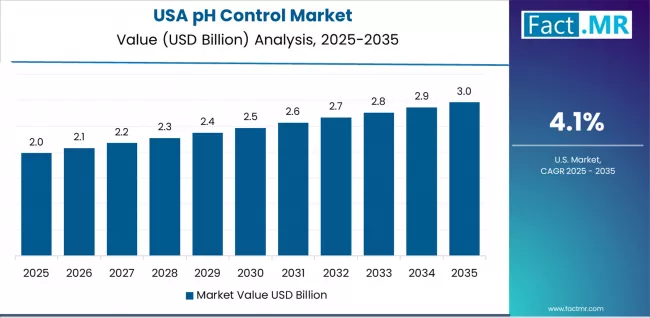
American ingredient suppliers leverage established distribution networks and comprehensive technical capabilities, including application support programs and formulation services that create customer relationships and operational advantages. The market benefits from mature food safety standards and processing requirements that encourage pH control system use while supporting technology advancement and quality optimization.
Strategic Market Indicators:
- Food processing and beverage manufacturing facilities maintaining 78% adoption rate with comprehensive pH control deployment
- Established FDA compliance standards providing consistent demand for pH control technology advancement
- Contract food manufacturing networks capturing 58% market share through operational flexibility and quality assurance
- Technology integration programs expanding pH control capabilities in food processing scenarios
Mexico Shows Strong Regional Growth
Mexico's market expansion benefits from diverse food demand, including processing modernization and beverage facility development that increasingly incorporate pH control solutions for quality enhancement applications. The country maintains a 3.8% growth rate, driven by rising food processing activity and increasing recognition of pH control benefits, including improved product quality and shelf stability.
Market dynamics focus on cost-effective pH control solutions that balance advanced functionality with affordability considerations important to Mexican food operators. Growing food industrialization creates continued demand for modern pH control systems in new facility infrastructure and processing modernization projects.
Germany Maintains Technology Leadership
Germany's advanced food technology market demonstrates sophisticated pH control system deployment with documented effectiveness in food processing applications and manufacturing facilities through integration with existing quality systems and processing infrastructure. The country leverages engineering expertise in food technology and quality systems integration to maintain a 3.4% growth rate. Industrial centers showcase premium installations where pH control systems integrate with comprehensive processing platforms and facility management systems to optimize quality operations and product consistency.
German manufacturers prioritize system precision and EU compliance in pH control development, creating demand for premium systems with advanced features, including process automation integration and comprehensive quality systems. The market benefits from established food technology infrastructure and a willingness to invest in advanced pH control technologies that provide long-term processing benefits and compliance with international food standards.
France Shows Steady Market Development
France maintains steady market growth through established food processing programs and quality control modernization, integrating pH control systems in food and beverage applications. The country's 3.3% growth rate reflects comprehensive food industry support and mature quality assurance adoption that promotes widespread use of acidulation systems in food processing and specialty manufacturing facilities.
French facilities prioritize pH control system reliability and EU regulatory compliance, creating demand for natural systems with proven performance and comprehensive documentation support. The market benefits from established food processing infrastructure and government support for food technology development that encourages pH control advancement.
UK Demonstrates Market Stability
UK's food market showcases stable pH control system adoption with 3.2% growth rate through comprehensive food processing programs and quality control initiatives. The country benefits from established food technology infrastructure and regulatory expertise that supports pH control system deployment across food and beverage applications.
Market development focuses on process integration and natural pH control solutions that align with UK food industry modernization programs. Brexit considerations create opportunities for domestic ingredient development while maintaining access to international food markets.
South Korea Emerges as Processing Market
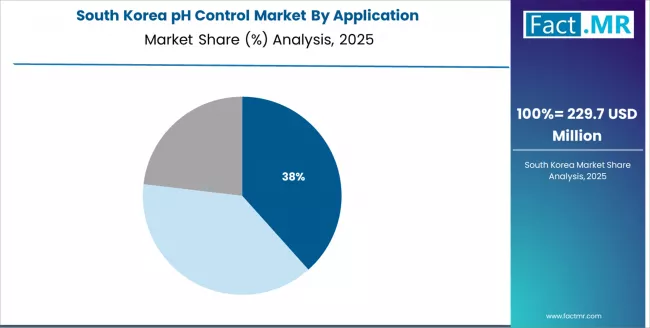
South Korea establishes market position through food processing development and manufacturing expansion, integrating pH control systems as standard quality components in food and beverage manufacturing installations. The country's 3.2% growth rate reflects government initiatives promoting food industry advancement and domestic processing capabilities that support advanced pH control systems.
Korean manufacturers are developing specialized pH control solutions that combine domestic technology advantages with international quality standards, including automated dosing and enhanced consistency capabilities. Government support for food industry development supports adoption across diverse food processing and beverage segments.
Europe Market Split by Country
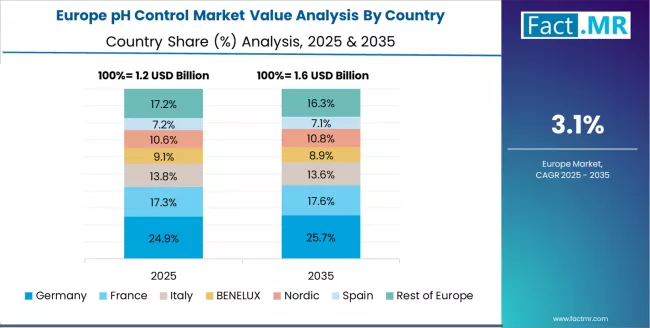
The European pH control market is projected to grow from USD 1.8 billion in 2025 to USD 2.5 billion by 2035, registering a CAGR of 3.4% over the forecast period. Germany is expected to maintain its leadership position with a 32.1% market share in 2025, supported by its advanced food processing technology infrastructure and major manufacturing centers.
United Kingdom follows with a 24.3% share in 2025, driven by comprehensive food processing programs and pH control technology development initiatives. France holds a 21.7% share through specialized food applications and quality compliance requirements. Italy commands a 13.2% share, while Spain accounts for 8.7% in 2025. The rest of Europe region is anticipated to gain momentum, expanding its collective share from 6.8% to 7.2% by 2035, attributed to increasing food processing adoption in Nordic countries and emerging facilities implementing quality modernization programs.
Competitive Landscape of the pH Control Market
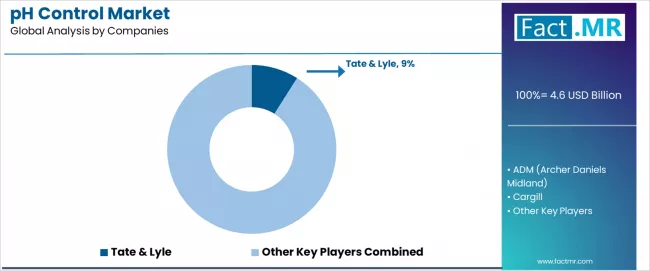
- Structure: ~20-25 credible players; top 3-5 hold ~45-50% by revenue
- Leadership is maintained through: global supply chains, technical support, and application expertise (formulation + processing + regulatory)
- What's commoditizing: basic citric acid and standard phosphate systems
- Margin Opportunities: technical services, custom formulations, and integration into processing workflows (automated dosing, process control)
| Stakeholder | What they actually control | Typical strengths | Typical blind spots |
|---|---|---|---|
| Global platforms | Supply chain reach, technical support, regulatory expertise | Broad market coverage, proven applications, multi-region supply | Product differentiation; customer dependency |
| Specialty chemical innovators | R&D capabilities; custom formulations; application development | Latest solutions first; superior performance characteristics | Service complexity outside core markets; scale limitations |
| Regional suppliers | Local supply, rapid delivery, nearby technical support | "Close to facility" service; competitive pricing; regional expertise | Technology gaps; talent retention in technical service |
| Application specialists | Technical support, formulation assistance, processing optimization | Lowest application issues; comprehensive food industry support | Service costs if overpromised; market limitations |
| Commodity suppliers | Cost efficiency, volume supply, basic applications | Win price-sensitive applications; reliable supply | Limited differentiation; margin pressure |
Key Players in the pH Control Market
- Tate & Lyle
- ADM (Archer Daniels Midland)
- Cargill
- Corbion
- Jungbunzlauer
- Kerry Group
- DSM-Firmenich
- Novozymes
- FBC Industries
- Archer Chemicals
Scope of the Report
| Item | Value |
|---|---|
| Quantitative Units | USD 4.6 billion |
| Product | Citric Acid, Phosphates, Others |
| Application | Beverages, Bakery & Confectionery, Dairy/Others |
| Function | Acidulants, Buffers, Stabilizers/Others |
| Regions Covered | North America, Latin America, Europe, East Asia, South Asia Pacific, Middle East & Africa |
| Countries Covered | United States, Germany, United Kingdom, France, Japan, China, South Korea, Mexico, India, Canada, and 25+ additional countries |
| Key Companies Profiled | Tate & Lyle, ADM, Cargill, Corbion, Jungbunzlauer, Kerry Group, DSM-Firmenich, Novozymes, FBC Industries, Archer Chemicals |
| Additional Attributes | Dollar sales by product and application categories, regional adoption trends across North America, Europe, and East Asia, competitive landscape with food ingredient manufacturers and specialty chemical suppliers, food operator preferences for natural acidulants and system reliability, integration with processing platforms and quality monitoring systems, innovations in pH control technology and formulation enhancement, and development of multi-functional solutions with enhanced performance and food processing optimization capabilities. |
pH Control Market by Segments
-
Product:
- Citric Acid
- Phosphates
- Others
-
Application:
- Beverages
- Bakery & Confectionery
- Dairy/Others
-
Function:
- Acidulants
- Buffers
- Stabilizers/Others
-
Region:
- North America
- United States
- Canada
- Mexico
- Latin America
- Brazil
- Argentina
- Rest of Latin America
- Europe
- Germany
- United Kingdom
- France
- Italy
- Spain
- Nordic
- BENELUX
- Rest of Europe
- East Asia
- China
- Japan
- South Korea
- South Asia Pacific
- India
- ASEAN
- Australia & New Zealand
- Rest of South Asia Pacific
- Middle East & Africa
- Kingdom of Saudi Arabia
- Other GCC Countries
- Turkey
- South Africa
- Other African Union
- Rest of Middle East & Africa
- North America
Table of Content
- Executive Summary
- Global Market Outlook
- Demand to side Trends
- Supply to side Trends
- Technology Roadmap Analysis
- Analysis and Recommendations
- Market Overview
- Market Coverage / Taxonomy
- Market Definition / Scope / Limitations
- Market Background
- Market Dynamics
- Drivers
- Restraints
- Opportunity
- Trends
- Scenario Forecast
- Demand in Optimistic Scenario
- Demand in Likely Scenario
- Demand in Conservative Scenario
- Opportunity Map Analysis
- Product Life Cycle Analysis
- Supply Chain Analysis
- Investment Feasibility Matrix
- Value Chain Analysis
- PESTLE and Porter’s Analysis
- Regulatory Landscape
- Regional Parent Market Outlook
- Production and Consumption Statistics
- Import and Export Statistics
- Market Dynamics
- Global Market Analysis 2020 to 2024 and Forecast, 2025 to 2035
- Historical Market Size Value (USD Million) Analysis, 2020 to 2024
- Current and Future Market Size Value (USD Million) Projections, 2025 to 2035
- Y to o to Y Growth Trend Analysis
- Absolute $ Opportunity Analysis
- Global Market Pricing Analysis 2020 to 2024 and Forecast 2025 to 2035
- Global Market Analysis 2020 to 2024 and Forecast 2025 to 2035, By Product
- Introduction / Key Findings
- Historical Market Size Value (USD Million) Analysis By Product , 2020 to 2024
- Current and Future Market Size Value (USD Million) Analysis and Forecast By Product , 2025 to 2035
- Citric Acid
- Phosphates
- Others
- Y to o to Y Growth Trend Analysis By Product , 2020 to 2024
- Absolute $ Opportunity Analysis By Product , 2025 to 2035
- Global Market Analysis 2020 to 2024 and Forecast 2025 to 2035, By Application
- Introduction / Key Findings
- Historical Market Size Value (USD Million) Analysis By Application, 2020 to 2024
- Current and Future Market Size Value (USD Million) Analysis and Forecast By Application, 2025 to 2035
- Beverages
- Bakery & Confectionery
- Dairy/Others
- Y to o to Y Growth Trend Analysis By Application, 2020 to 2024
- Absolute $ Opportunity Analysis By Application, 2025 to 2035
- Global Market Analysis 2020 to 2024 and Forecast 2025 to 2035, By Function
- Introduction / Key Findings
- Historical Market Size Value (USD Million) Analysis By Function, 2020 to 2024
- Current and Future Market Size Value (USD Million) Analysis and Forecast By Function, 2025 to 2035
- Acidulants
- Buffers
- Stabilizers/Others
- Y to o to Y Growth Trend Analysis By Function, 2020 to 2024
- Absolute $ Opportunity Analysis By Function, 2025 to 2035
- Global Market Analysis 2020 to 2024 and Forecast 2025 to 2035, By Region
- Introduction
- Historical Market Size Value (USD Million) Analysis By Region, 2020 to 2024
- Current Market Size Value (USD Million) Analysis and Forecast By Region, 2025 to 2035
- North America
- Latin America
- Western Europe
- Eastern Europe
- East Asia
- South Asia and Pacific
- Middle East & Africa
- Market Attractiveness Analysis By Region
- North America Market Analysis 2020 to 2024 and Forecast 2025 to 2035, By Country
- Historical Market Size Value (USD Million) Trend Analysis By Market Taxonomy, 2020 to 2024
- Market Size Value (USD Million) Forecast By Market Taxonomy, 2025 to 2035
- By Country
- USA
- Canada
- Mexico
- By Product
- By Application
- By Function
- By Country
- Market Attractiveness Analysis
- By Country
- By Product
- By Application
- By Function
- Key Takeaways
- Latin America Market Analysis 2020 to 2024 and Forecast 2025 to 2035, By Country
- Historical Market Size Value (USD Million) Trend Analysis By Market Taxonomy, 2020 to 2024
- Market Size Value (USD Million) Forecast By Market Taxonomy, 2025 to 2035
- By Country
- Brazil
- Chile
- Rest of Latin America
- By Product
- By Application
- By Function
- By Country
- Market Attractiveness Analysis
- By Country
- By Product
- By Application
- By Function
- Key Takeaways
- Western Europe Market Analysis 2020 to 2024 and Forecast 2025 to 2035, By Country
- Historical Market Size Value (USD Million) Trend Analysis By Market Taxonomy, 2020 to 2024
- Market Size Value (USD Million) Forecast By Market Taxonomy, 2025 to 2035
- By Country
- Germany
- UK
- Italy
- Spain
- France
- Nordic
- BENELUX
- Rest of Western Europe
- By Product
- By Application
- By Function
- By Country
- Market Attractiveness Analysis
- By Country
- By Product
- By Application
- By Function
- Key Takeaways
- Eastern Europe Market Analysis 2020 to 2024 and Forecast 2025 to 2035, By Country
- Historical Market Size Value (USD Million) Trend Analysis By Market Taxonomy, 2020 to 2024
- Market Size Value (USD Million) Forecast By Market Taxonomy, 2025 to 2035
- By Country
- Russia
- Poland
- Hungary
- Balkan & Baltic
- Rest of Eastern Europe
- By Product
- By Application
- By Function
- By Country
- Market Attractiveness Analysis
- By Country
- By Product
- By Application
- By Function
- Key Takeaways
- East Asia Market Analysis 2020 to 2024 and Forecast 2025 to 2035, By Country
- Historical Market Size Value (USD Million) Trend Analysis By Market Taxonomy, 2020 to 2024
- Market Size Value (USD Million) Forecast By Market Taxonomy, 2025 to 2035
- By Country
- China
- Japan
- South Korea
- By Product
- By Application
- By Function
- By Country
- Market Attractiveness Analysis
- By Country
- By Product
- By Application
- By Function
- Key Takeaways
- South Asia and Pacific Market Analysis 2020 to 2024 and Forecast 2025 to 2035, By Country
- Historical Market Size Value (USD Million) Trend Analysis By Market Taxonomy, 2020 to 2024
- Market Size Value (USD Million) Forecast By Market Taxonomy, 2025 to 2035
- By Country
- India
- ASEAN
- Australia & New Zealand
- Rest of South Asia and Pacific
- By Product
- By Application
- By Function
- By Country
- Market Attractiveness Analysis
- By Country
- By Product
- By Application
- By Function
- Key Takeaways
- Middle East & Africa Market Analysis 2020 to 2024 and Forecast 2025 to 2035, By Country
- Historical Market Size Value (USD Million) Trend Analysis By Market Taxonomy, 2020 to 2024
- Market Size Value (USD Million) Forecast By Market Taxonomy, 2025 to 2035
- By Country
- Kingdom of Saudi Arabia
- Other GCC Countries
- Turkiye
- South Africa
- Other African Union
- Rest of Middle East & Africa
- By Product
- By Application
- By Function
- By Country
- Market Attractiveness Analysis
- By Country
- By Product
- By Application
- By Function
- Key Takeaways
- Key Countries Market Analysis
- USA
- Pricing Analysis
- Market Share Analysis, 2024
- By Product
- By Application
- By Function
- Canada
- Pricing Analysis
- Market Share Analysis, 2024
- By Product
- By Application
- By Function
- Mexico
- Pricing Analysis
- Market Share Analysis, 2024
- By Product
- By Application
- By Function
- Brazil
- Pricing Analysis
- Market Share Analysis, 2024
- By Product
- By Application
- By Function
- Chile
- Pricing Analysis
- Market Share Analysis, 2024
- By Product
- By Application
- By Function
- Germany
- Pricing Analysis
- Market Share Analysis, 2024
- By Product
- By Application
- By Function
- UK
- Pricing Analysis
- Market Share Analysis, 2024
- By Product
- By Application
- By Function
- Italy
- Pricing Analysis
- Market Share Analysis, 2024
- By Product
- By Application
- By Function
- Spain
- Pricing Analysis
- Market Share Analysis, 2024
- By Product
- By Application
- By Function
- France
- Pricing Analysis
- Market Share Analysis, 2024
- By Product
- By Application
- By Function
- India
- Pricing Analysis
- Market Share Analysis, 2024
- By Product
- By Application
- By Function
- ASEAN
- Pricing Analysis
- Market Share Analysis, 2024
- By Product
- By Application
- By Function
- Australia & New Zealand
- Pricing Analysis
- Market Share Analysis, 2024
- By Product
- By Application
- By Function
- China
- Pricing Analysis
- Market Share Analysis, 2024
- By Product
- By Application
- By Function
- Japan
- Pricing Analysis
- Market Share Analysis, 2024
- By Product
- By Application
- By Function
- South Korea
- Pricing Analysis
- Market Share Analysis, 2024
- By Product
- By Application
- By Function
- Russia
- Pricing Analysis
- Market Share Analysis, 2024
- By Product
- By Application
- By Function
- Poland
- Pricing Analysis
- Market Share Analysis, 2024
- By Product
- By Application
- By Function
- Hungary
- Pricing Analysis
- Market Share Analysis, 2024
- By Product
- By Application
- By Function
- Kingdom of Saudi Arabia
- Pricing Analysis
- Market Share Analysis, 2024
- By Product
- By Application
- By Function
- Turkiye
- Pricing Analysis
- Market Share Analysis, 2024
- By Product
- By Application
- By Function
- South Africa
- Pricing Analysis
- Market Share Analysis, 2024
- By Product
- By Application
- By Function
- USA
- Market Structure Analysis
- Competition Dashboard
- Competition Benchmarking
- Market Share Analysis of Top Players
- By Regional
- By Product
- By Application
- By Function
- Competition Analysis
- Competition Deep Dive
- Tate & Lyle
- Overview
- Product Portfolio
- Profitability by Market Segments (Product/Age /Sales Channel/Region)
- Sales Footprint
- Strategy Overview
- Marketing Strategy
- Product Strategy
- Channel Strategy
- ADM (Archer Daniels Midland)
- Cargill
- Corbion
- Jungbunzlauer
- Kerry Group
- DSM-Firmenich
- Novozymes
- FBC Industries
- Archer Chemicals
- Tate & Lyle
- Competition Deep Dive
- Assumptions & Acronyms Used
- Research Methodology
List Of Table
- Table 1: Global Market Value (USD Million) Forecast by Region, 2020 to 2035
- Table 2: Global Market Value (USD Million) Forecast by Product , 2020 to 2035
- Table 3: Global Market Value (USD Million) Forecast by Application, 2020 to 2035
- Table 4: Global Market Value (USD Million) Forecast by Function, 2020 to 2035
- Table 5: North America Market Value (USD Million) Forecast by Country, 2020 to 2035
- Table 6: North America Market Value (USD Million) Forecast by Product , 2020 to 2035
- Table 7: North America Market Value (USD Million) Forecast by Application, 2020 to 2035
- Table 8: North America Market Value (USD Million) Forecast by Function, 2020 to 2035
- Table 9: Latin America Market Value (USD Million) Forecast by Country, 2020 to 2035
- Table 10: Latin America Market Value (USD Million) Forecast by Product , 2020 to 2035
- Table 11: Latin America Market Value (USD Million) Forecast by Application, 2020 to 2035
- Table 12: Latin America Market Value (USD Million) Forecast by Function, 2020 to 2035
- Table 13: Western Europe Market Value (USD Million) Forecast by Country, 2020 to 2035
- Table 14: Western Europe Market Value (USD Million) Forecast by Product , 2020 to 2035
- Table 15: Western Europe Market Value (USD Million) Forecast by Application, 2020 to 2035
- Table 16: Western Europe Market Value (USD Million) Forecast by Function, 2020 to 2035
- Table 17: Eastern Europe Market Value (USD Million) Forecast by Country, 2020 to 2035
- Table 18: Eastern Europe Market Value (USD Million) Forecast by Product , 2020 to 2035
- Table 19: Eastern Europe Market Value (USD Million) Forecast by Application, 2020 to 2035
- Table 20: Eastern Europe Market Value (USD Million) Forecast by Function, 2020 to 2035
- Table 21: East Asia Market Value (USD Million) Forecast by Country, 2020 to 2035
- Table 22: East Asia Market Value (USD Million) Forecast by Product , 2020 to 2035
- Table 23: East Asia Market Value (USD Million) Forecast by Application, 2020 to 2035
- Table 24: East Asia Market Value (USD Million) Forecast by Function, 2020 to 2035
- Table 25: South Asia and Pacific Market Value (USD Million) Forecast by Country, 2020 to 2035
- Table 26: South Asia and Pacific Market Value (USD Million) Forecast by Product , 2020 to 2035
- Table 27: South Asia and Pacific Market Value (USD Million) Forecast by Application, 2020 to 2035
- Table 28: South Asia and Pacific Market Value (USD Million) Forecast by Function, 2020 to 2035
- Table 29: Middle East & Africa Market Value (USD Million) Forecast by Country, 2020 to 2035
- Table 30: Middle East & Africa Market Value (USD Million) Forecast by Product , 2020 to 2035
- Table 31: Middle East & Africa Market Value (USD Million) Forecast by Application, 2020 to 2035
- Table 32: Middle East & Africa Market Value (USD Million) Forecast by Function, 2020 to 2035
List Of Figures
- Figure 1: Global Market Pricing Analysis
- Figure 2: Global Market Value (USD Million) Forecast 2020-2035
- Figure 3: Global Market Value Share and BPS Analysis by Product , 2025 and 2035
- Figure 4: Global Market Y to o to Y Growth Comparison by Product , 2025-2035
- Figure 5: Global Market Attractiveness Analysis by Product
- Figure 6: Global Market Value Share and BPS Analysis by Application, 2025 and 2035
- Figure 7: Global Market Y to o to Y Growth Comparison by Application, 2025-2035
- Figure 8: Global Market Attractiveness Analysis by Application
- Figure 9: Global Market Value Share and BPS Analysis by Function, 2025 and 2035
- Figure 10: Global Market Y to o to Y Growth Comparison by Function, 2025-2035
- Figure 11: Global Market Attractiveness Analysis by Function
- Figure 12: Global Market Value (USD Million) Share and BPS Analysis by Region, 2025 and 2035
- Figure 13: Global Market Y to o to Y Growth Comparison by Region, 2025-2035
- Figure 14: Global Market Attractiveness Analysis by Region
- Figure 15: North America Market Incremental Dollar Opportunity, 2025-2035
- Figure 16: Latin America Market Incremental Dollar Opportunity, 2025-2035
- Figure 17: Western Europe Market Incremental Dollar Opportunity, 2025-2035
- Figure 18: Eastern Europe Market Incremental Dollar Opportunity, 2025-2035
- Figure 19: East Asia Market Incremental Dollar Opportunity, 2025-2035
- Figure 20: South Asia and Pacific Market Incremental Dollar Opportunity, 2025-2035
- Figure 21: Middle East & Africa Market Incremental Dollar Opportunity, 2025-2035
- Figure 22: North America Market Value Share and BPS Analysis by Country, 2025 and 2035
- Figure 23: North America Market Value Share and BPS Analysis by Product , 2025 and 2035
- Figure 24: North America Market Y to o to Y Growth Comparison by Product , 2025-2035
- Figure 25: North America Market Attractiveness Analysis by Product
- Figure 26: North America Market Value Share and BPS Analysis by Application, 2025 and 2035
- Figure 27: North America Market Y to o to Y Growth Comparison by Application, 2025-2035
- Figure 28: North America Market Attractiveness Analysis by Application
- Figure 29: North America Market Value Share and BPS Analysis by Function, 2025 and 2035
- Figure 30: North America Market Y to o to Y Growth Comparison by Function, 2025-2035
- Figure 31: North America Market Attractiveness Analysis by Function
- Figure 32: Latin America Market Value Share and BPS Analysis by Country, 2025 and 2035
- Figure 33: Latin America Market Value Share and BPS Analysis by Product , 2025 and 2035
- Figure 34: Latin America Market Y to o to Y Growth Comparison by Product , 2025-2035
- Figure 35: Latin America Market Attractiveness Analysis by Product
- Figure 36: Latin America Market Value Share and BPS Analysis by Application, 2025 and 2035
- Figure 37: Latin America Market Y to o to Y Growth Comparison by Application, 2025-2035
- Figure 38: Latin America Market Attractiveness Analysis by Application
- Figure 39: Latin America Market Value Share and BPS Analysis by Function, 2025 and 2035
- Figure 40: Latin America Market Y to o to Y Growth Comparison by Function, 2025-2035
- Figure 41: Latin America Market Attractiveness Analysis by Function
- Figure 42: Western Europe Market Value Share and BPS Analysis by Country, 2025 and 2035
- Figure 43: Western Europe Market Value Share and BPS Analysis by Product , 2025 and 2035
- Figure 44: Western Europe Market Y to o to Y Growth Comparison by Product , 2025-2035
- Figure 45: Western Europe Market Attractiveness Analysis by Product
- Figure 46: Western Europe Market Value Share and BPS Analysis by Application, 2025 and 2035
- Figure 47: Western Europe Market Y to o to Y Growth Comparison by Application, 2025-2035
- Figure 48: Western Europe Market Attractiveness Analysis by Application
- Figure 49: Western Europe Market Value Share and BPS Analysis by Function, 2025 and 2035
- Figure 50: Western Europe Market Y to o to Y Growth Comparison by Function, 2025-2035
- Figure 51: Western Europe Market Attractiveness Analysis by Function
- Figure 52: Eastern Europe Market Value Share and BPS Analysis by Country, 2025 and 2035
- Figure 53: Eastern Europe Market Value Share and BPS Analysis by Product , 2025 and 2035
- Figure 54: Eastern Europe Market Y to o to Y Growth Comparison by Product , 2025-2035
- Figure 55: Eastern Europe Market Attractiveness Analysis by Product
- Figure 56: Eastern Europe Market Value Share and BPS Analysis by Application, 2025 and 2035
- Figure 57: Eastern Europe Market Y to o to Y Growth Comparison by Application, 2025-2035
- Figure 58: Eastern Europe Market Attractiveness Analysis by Application
- Figure 59: Eastern Europe Market Value Share and BPS Analysis by Function, 2025 and 2035
- Figure 60: Eastern Europe Market Y to o to Y Growth Comparison by Function, 2025-2035
- Figure 61: Eastern Europe Market Attractiveness Analysis by Function
- Figure 62: East Asia Market Value Share and BPS Analysis by Country, 2025 and 2035
- Figure 63: East Asia Market Value Share and BPS Analysis by Product , 2025 and 2035
- Figure 64: East Asia Market Y to o to Y Growth Comparison by Product , 2025-2035
- Figure 65: East Asia Market Attractiveness Analysis by Product
- Figure 66: East Asia Market Value Share and BPS Analysis by Application, 2025 and 2035
- Figure 67: East Asia Market Y to o to Y Growth Comparison by Application, 2025-2035
- Figure 68: East Asia Market Attractiveness Analysis by Application
- Figure 69: East Asia Market Value Share and BPS Analysis by Function, 2025 and 2035
- Figure 70: East Asia Market Y to o to Y Growth Comparison by Function, 2025-2035
- Figure 71: East Asia Market Attractiveness Analysis by Function
- Figure 72: South Asia and Pacific Market Value Share and BPS Analysis by Country, 2025 and 2035
- Figure 73: South Asia and Pacific Market Value Share and BPS Analysis by Product , 2025 and 2035
- Figure 74: South Asia and Pacific Market Y to o to Y Growth Comparison by Product , 2025-2035
- Figure 75: South Asia and Pacific Market Attractiveness Analysis by Product
- Figure 76: South Asia and Pacific Market Value Share and BPS Analysis by Application, 2025 and 2035
- Figure 77: South Asia and Pacific Market Y to o to Y Growth Comparison by Application, 2025-2035
- Figure 78: South Asia and Pacific Market Attractiveness Analysis by Application
- Figure 79: South Asia and Pacific Market Value Share and BPS Analysis by Function, 2025 and 2035
- Figure 80: South Asia and Pacific Market Y to o to Y Growth Comparison by Function, 2025-2035
- Figure 81: South Asia and Pacific Market Attractiveness Analysis by Function
- Figure 82: Middle East & Africa Market Value Share and BPS Analysis by Country, 2025 and 2035
- Figure 83: Middle East & Africa Market Value Share and BPS Analysis by Product , 2025 and 2035
- Figure 84: Middle East & Africa Market Y to o to Y Growth Comparison by Product , 2025-2035
- Figure 85: Middle East & Africa Market Attractiveness Analysis by Product
- Figure 86: Middle East & Africa Market Value Share and BPS Analysis by Application, 2025 and 2035
- Figure 87: Middle East & Africa Market Y to o to Y Growth Comparison by Application, 2025-2035
- Figure 88: Middle East & Africa Market Attractiveness Analysis by Application
- Figure 89: Middle East & Africa Market Value Share and BPS Analysis by Function, 2025 and 2035
- Figure 90: Middle East & Africa Market Y to o to Y Growth Comparison by Function, 2025-2035
- Figure 91: Middle East & Africa Market Attractiveness Analysis by Function
- Figure 92: Global Market - Tier Structure Analysis
- Figure 93: Global Market - Company Share Analysis
- FAQs -
How big is the pH control market in 2025?
The global pH control market is estimated to be valued at USD 4.6 billion in 2025.
What will be the size of pH control market in 2035?
The market size for the pH control market is projected to reach USD 6.6 billion by 2035.
How much will be the pH control market growth between 2025 and 2035?
The pH control market is expected to grow at a 3.7% CAGR between 2025 and 2035.
What are the key product types in the pH control market?
The key product types in pH control market are citric acid, phosphates and others.
Which application segment to contribute significant share in the pH control market in 2025?
In terms of application, beverages segment to command 37.0% share in the pH control market in 2025.